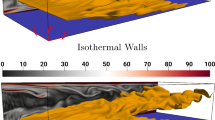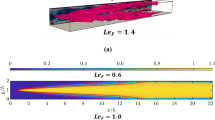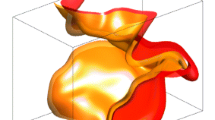Abstract
The head on quenching of statistically planar turbulent premixed flames by an isothermal inert wall has been analysed using three-dimensional Direct Numerical Simulation (DNS) data for different values of global Lewis number Le(0.8, 1.0 and 1.2) and turbulent Reynolds number R e t . The statistics of head on quenching have been analysed in terms of the wall Peclet number P e (i.e. distance of the flame from the wall normalised by the Zel’dovich flame thickness) and the normalised wall heat flux Φ. It has been found that the maximum (minimum) value of Φ(P e) for the turbulent L e=0.8 cases are greater (smaller) than the corresponding laminar value, whereas both P e and Φ in turbulent cases remain comparable to the corresponding laminar values for L e=1.0 and 1.2. Detailed physical explanations are provided for the observed Le dependences of P e and Φ. The existing closure of mean reaction rate \(\overline {\dot {\omega }}\) using the scalar dissipation rate (SDR) in the near wall region has been assessed based on a-priori analysis of DNS data and modifications to the existing closures of mean reaction rate and SDR have been suggested to account for the wall effects in such a manner that the modified closures perform well both near to and away from the wall.
Similar content being viewed by others
References
Heywood, J.B.: Internal combustion engine fundamentals. Mcgraw-Hill, New York (1988)
Poinsot, T., Veynante, D.: Theoretical and numerical combustion (2005)
Poinsot, T., Haworth, D., Bruneaux, G.: Direct simulation and modeling of flame-wall interaction for premixed turbulent combustion. Combust. Flame 95, 118–132 (1993)
Bruneaux, G., Akselvoll, K., Poinsot, T., Ferziger, J.: Flame-wall interaction simulation in a turbulent channel flow. Combust. Flame 107, 27–44 (1996)
Bruneaux, G., Poinsot, T., Ferziger, J.: Premixed flame-wall interaction in a turbulent channel flow: budget for the flame surface density evolution equation and modelling. J. Fluid Mech. 349, 191–219 (1997)
Alshaalan, T.M., Rutland, C.J.: Turbulence, scalar transport, and reaction rates in flame-wall interaction. Proc. Combust. Inst. 27, 793–799 (1998)
Alshaalan, T., Rutland, C.J.: Wall heat flux in turbulent premixed reacting flow. Combust. Sci. Technol. 174, 135–165 (2002)
Gruber, A., Sankaran, R., Hawkes, E., Chen, J.: Turbulent flame-wall interaction: a direct numerical simulation study. J Fluid Mech. 658, 5–32 (2010)
Dabireau, F., Cuenot, B., Vermorel, O., Poinsot, T.: Interaction of flames of H 2+O 2 with inert walls. Combust. Flame 135, 123–133 (2003)
Cebeci, T., Cousteix, J.: Modeling and computation of boundary-layer flows. Springer (2005)
Bilger, R.: Some aspects of scalar dissipation. Flow. Turb. Combust. 72, 93–114 (2004)
Bray, K.: Turbulent flows with premixed reactants. In: Turbulent reacting flows, 115-183. Springer (1980)
Chakraborty, N., Champion, M., Mura, A., Swaminathan, N.: Scalar dissipation rate approach to reaction rate closure. In: Swaminathan, N., Bray, K.N.C. (eds.) Turbulent premixed flame, pp 76–1023. Cambridge University Press, Cambridge (2011)
Borghi, R.: Turbulent premixed combustion: Further discussions on the scales of fluctuations. Combust. Flame 80, 304–312 (1990)
Mantel, T., Borghi, R.: A new model of premixed wrinkled flame propagation based on a scalar dissipation equation. Combust. Flame 96, 443–457 (1994)
Mura, A., Borghi, R.: Towards an extended scalar dissipation equation for turbulent premixed combustion. Combust. Flame 133, 193–196 (2003)
Swaminathan, N., Bray, K.: Effect of dilatation on scalar dissipation in turbulent premixed flames. Combust. Flame 143, 549–565 (2005)
Chakraborty, N., Swaminathan, N.: Influence of the Damkohler number on turbulence-scalar interaction in premixed flames. I. Physical insight. Phys. Fluids 19, 045103 (2007)
Chakraborty, N., Swaminathan, N.: Influence of the Damkohler number on turbulence-scalar interaction in premixed flames. II. Model development. Phys. Fluids 19, 045104 (2007)
Mura, A., Tsuboi, K., Hasegawa, T.: Modelling of the correlation between velocity and reactive scalar gradients in turbulent premixed flames based on DNS data. Combust. Theor. Modell. 12, 671–698 (2008)
Mura, A., Robin, V, Champion, M., Hasegawa, T.: Small-scale features of velocity and scalar fields of turbulent premixed flames. Flow Turbul. Combust. 82, 339–358 (2009)
Kolla, H., Rogerson, J., Chakraborty, N., Swaminathan, N.: Scalar dissipation rate modeling and its validation. Combust. Sci. Technol. 181, 518–535 (2009)
Chakraborty, N., Swaminathan, N.: Effects of Lewis number on scalar dissipation transport and its modelling implications for turbulent premixed combustion. Combust. Sci. Technol. 182, 1201–1240 (2010)
Chakraborty, N., Swaminathan, N.: Effects of Lewis number on scalar variance transport in premixed flames. Flow Turb. Combust. 87, 261–292 (2011)
Chakraborty, N., Swaminathan, N.: Effects of turbulent Reynolds number on the scalar dissipation rate transport in turbulent premixed flames in the context of Reynolds Averaged Navier Stokes simulations. Combust. Sci. Technol. 185, 676–709 (2013)
Mizomoto, M., Asaka, S., Ikai, S., Law, C.: Effects of preferential diffusion on the burning intensity of curved flames. Proc. Combust. Inst. 20, 1933–1940 (1984)
Dinkelacker, F., Manickam, B., Muppala, S.: Modelling and simulation of lean premixed turbulent methane/hydrogen/air flames with an effective Lewis number approach. Combust. Flame 158, 1742–1749 (2011)
Clavin, P., Williams, F.: Effects of molecular diffusion and of thermal expansion on the structure and dynamics of premixed flames in turbulent flows of large scale and low intensity. J. Fluid Mech. 116, 251–282 (1982)
Pelce, P., Clavin, P.: Influence of hydrodynamics and diffusion upon the stability limits of laminar premixed flames. J. Fluid Mech. 124, 219–237 (1982)
Sivashinsky, G.I.: Instabilities, pattern formation, and turbulence in flames. An. Rev. Fluid Mech. 15, 179–199 (1983)
Abdel-Gayed, R., Bradley, D., Hamid, M., Lawes, M.: Lewis number effects on turbulent burning velocity. Proc. Combust. Inst. 20, 505–512 (1985)
Libby, P.A., Linan, A., Williams, F.A.: Strained premixed laminar flames with nonunity lewis numbers. Combust. Sci. Technol. 34, 257–293 (1983)
Renou, B., Boukhalfa, A., Puechberty, D., Trinite, M.: Effects of stretch on the local structure of preely propagating premixed low-turbulent flames with various Lewis numbers. Proc. Combust. Inst. 27, 841–847 (1998)
Haworth, D., Poinsot, T.: Numerical simulations of Lewis number effects in turbulent premixed flames. J. Fluid Mech. 244, 405–436 (1992)
Rutland, C., Trouve, A.: Direct simulations of premixed turbulent flames with nonunity Lewis numbers. Combust. Flame 94, 41–57 (1993)
Trouve, A., Poinsot, T.: The evolution equation for the flame surface density in turbulent premixed combustion. J. Fluid Mech. 278, 1–31 (1994)
Chakraborty, N., Cant, R.: Influence of lewis number on curvature effects in turbulent premixed flame propagation in the thin reaction zones regime. Phys. Fluids 17, 105105 (2005)
Chakraborty, N., Klein, M.: Influence of Lewis number on the surface density function transport in the thin reaction zones regime for turbulent premixed flames. Phys. Fluids 20, 065102 (2008)
Han, I., Huh, K.Y.: Roles of displacement speed on evolution of flame surface density for different turbulent intensities and lewis numbers in turbulent premixed combustion. Combust. Flame 152, 194–205 (2008)
Chakraborty, N., Cant, R.: Effects of lewis number on scalar transport in turbulent premixed flames. Phys. Fluids 21, 035110 (2009)
Chakraborty, N., Cant, R.: Effects of Lewis number on flame surface density transport in turbulent premixed combustion. Combust. Flame 158, 1768–1787 (2011)
Chen, J.H., Choudhary, A., De Supinski, B., DeVries, M., Hawkes, E., Klasky, S., Liao, W., Ma, K., Mellor-Crummey, J., Podhorszki, N., et al.: Terascale direct numerical simulations of turbulent combustion using s3d. Comput. Sci. Discov. 2, 015001 (2009)
Chakraborty, N., Hawkes, E.R., Chen, J.H., Cant, R.S.: Effects of strain rate and curvature on Surface Density Function transport in turbulent premixed CH 4-air and H 2-air flames: A comparative study. Combust. Flame 154, 259–280 (2008)
Peters, N., Terhoeven, P., Chen, J.H., Echekki, T.: Statistics of flame displacement speeds from computations of 2-D unsteady methane-air flames. Proc. Combust. Inst. 27, 833–839 (1998)
Echekki, T., Chen, J.H.: Analysis of the contribution of curvature to premixed flame propagation. Combust. Flame 118, 303–311 (1999)
Chakraborty, N., Kolla, H., Sankaran, R., Hawkes, E.R., Chen, J.H., Swaminathan, N.: Determination of three-dimensional quantities related to scalar dissipation rate and its transport from two-dimensional measurements: Direct Numerical Simulation based validation. Proc. Combust. Inst. 34, 1151–1162 (2013)
Jenkins, K.W., Cant, R.S.: Direct numerical simulation of turbulent flame kernels. In: Recent Advances in DNS and LES, 191–202. Springer (1999)
Boger, M., Veynante, D., Boughanem, H., Trouvé, A.: Direct numerical simulation analysis of flame surface density concept for large Eddy simulation of turbulent premixed combustion, Proc. Combust. Inst. 27, 917–925 (1998)
Swaminathan, N., Grout, R.G.: Interaction of turbulence and scalar fields in premixed flames. Phys. Fluids 18, 045102 (2006)
Chakraborty, N., Hartung, G., Katragadda, M., Kaminski, C.F.: A numerical comparison of 2D and 3D density-weighted displacement speed statistics and implications for laser based measurements of flame displacement speed. Combust. Flame 158, 1372–1390 (2011)
Dopazo, C, Cifuentes, L., Martin, J., Jimenez, C.: Strain rates normal to approaching iso-scalar surfaces in a turbulent premixed flame. Combust. Flame 158, 1729–1736 (2015)
Poinsot, T.J., Lele, S.: Boundary conditions for direct simulations of compressible viscous flows. J. Comput. Phys. 101, 104–129 (1992)
Wray, A.A.: Minimal storage time advancement schemes for spectral methods, unpublished report. NASA Ames Research Center, California (1990)
Rogallo, R.S.: Numerical experiments in homogeneous turbulence. NASA Ames Research Center, California (1981)
Peters, N.: Turbulent combustion. Cambridge University Press, Cambridge (2000)
Huang, W.M., Vosen, S.R., Greif, R.: Heat transfer during laminar flame quenching. Proc. Combust. Inst. 21, 1853–1860 (1986)
Jarosinsky, J.: A survey of recent studies on flame extinction. Combust. Sci. Technol 12, 81–116 (1986)
Vosen, S.R., Greif, R., Westbrook, C.: Unsteady heat transfer in laminar quenching. Proc. Combust. Inst 20, 76–83 (1984)
Bray, K.N.C., Libby, P.A., Moss, J.B.: Unified modelling approach for premixed turbulent combustion – Part I: General Formulation. Combust. Flame 61, 87–102 (1985)
Tennekes, H., Lumley, J.L.: A first course in turbulence. MIT press, Massachusetts (1972)
Chakraborty, N., Klein, M., Swaminathan, N.: Effects of Lewis number on reactive scalar gradient alignment with local strain rate in turbulent premixed flames. Proc. Combust. Inst. 32, 1409–1417 (2009)
Malkeson, S.P., Chakraborty, N: Alignment statistics of active and passive scalar gradients in turbulent stratified flames. Phys. Rev. E 83(4), 046308 (2011)
Author information
Authors and Affiliations
Corresponding author
Rights and permissions
About this article
Cite this article
Lai, J., Chakraborty, N. Effects of Lewis Number on Head on Quenching of Turbulent Premixed Flames: A Direct Numerical Simulation Analysis. Flow Turbulence Combust 96, 279–308 (2016). https://doi.org/10.1007/s10494-015-9629-x
Received:
Accepted:
Published:
Issue Date:
DOI: https://doi.org/10.1007/s10494-015-9629-x




